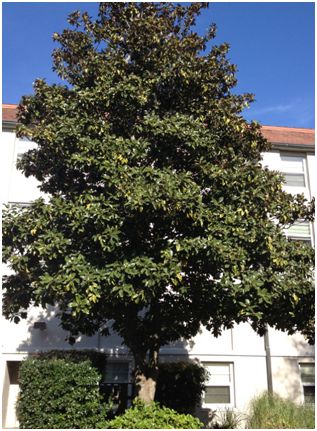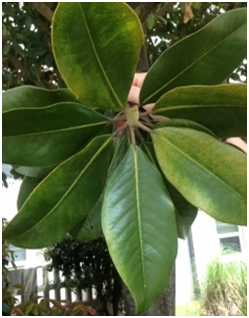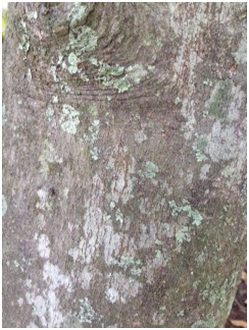Southern Magnolia
Magnolia grandiflora

(Photo by Brittany Tatum)
View the Location on Campus
Taxonomy (1,2)
Classification: Angiosperm, dicot (not eudicot)
Family: Magnoliaceae
Common name: Southern Magnolia
General Information (1,2)
Region of Origin: Southeast United States
USDA Plants Hardiness Zones: 6-9
Growth Habit: Tree
- Size: 60-90 feet
- Deciduous/Evergreen: Evergreen
- Flowering: Spring to summer
- Fruiting: Autumn
Diagnostic Characteristics
Leaves (2)
- Arrangement: Alternate
- Simple/Compound: Simple
- Shape: Obovate, oblong, elliptic
- Other: 5-10 inches, pubescent, coriaceous

(Photo by Brittany Tatum)
Stem/Bark (2)
- Color: Gray
- Texture: Smooth to scaly

(Photo by Brittany Tatum)
Flower (2)
- Perfect/Imperfect: Perfect
- Color: Creamy white
- Size: 8-12 inches
- Other: Fragrant
Fruit (2)
- Fruit type: Aggregate of follicles
- Size: 3-5 inches
(Photo by Jessica Bartek)
Horticultural Information (1,2)
- Light: Full sun to partial shade
- pH: Acidic
- Landscape Uses: Street tree, freestanding, framing tree, shade tree
Interesting Facts (1,2)
- It is essentially problem free of diseases and insects.
- It could take as long as 15 to 20 years for trees to flower.
References
1) Christman, S. Magnolia grandiflora.1997. Floridata. http://www.floridata.com/ref/m/magno_g.cfm.
2) Dirr, M. Manual of Woody Landscape Plants: Their Identification, Ornamental Characteristics, Culture, Propagation and Uses. 4th Ed. 1975. Stipes Publishing Company.
Prepared by Brittany Tatum as a course requirement for BIOL 3630/5630, Spring 2013
Edited by Jessica Bartek
Edited by Jessica Bartek
Department of Biology
-
Room 2035, 2nd Floor
Bailey Science Building -
Mailing Address
1500 N. Patterson St.
Valdosta, GA 31698 - Phone: 229.333.5759
- Fax: 229.245.6585
Monday - Thursday
8:00AM until 5:30PM
Friday
8:00AM until 3:00PM
Saturday - Sunday
Office Closed